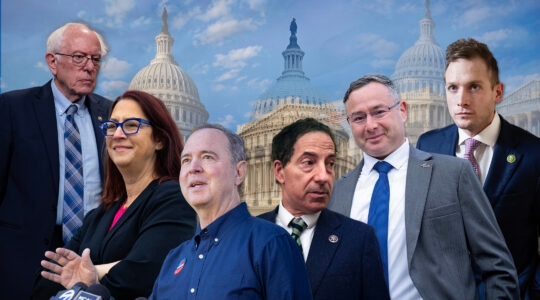The philanthropic world got a happy jolt last week when 40 members of the globe’s wealthy elite announced that they would give away more than half of their money before they died.
Earlier this summer, Bill Gates and Warren Buffett officially laid down the gauntlet to their financial peers and challenged them to give away the majority of their wealth before they died by taking what they dubbed The Giving Pledge.
When the names of the first 40 individuals and families who had signed on were announced Wednesday, the list included many of the usual suspects — those who have given away hundreds of millions of dollars. On the list were at least a dozen Jews. Their names are certainly familiar to the broader philanthropic world: Michael Bloomberg, Eli and Edith Broad, Barry Diller and Diane Von Furstenberg, Larry Ellison, Joan and Irwin Jacobs, George Kaiser, Lorry Lokey, Bernie and Millie Marcus, Bernard and Barbro Osher, David M. Rubenstein, Herb and Marion Sandler, Jeff Skoll, Sanford and Joan Weill and Shelby White.
How this pledge will affect the Jewish world is yet to be determined. While many, such as the late Jewish community researcher Gary Tobin, might make the case that any dollar a Jew gives away to charity should be considered Jewish philanthropy, critics often chide the Jewish philanthropic elite for only giving a small fraction of their charity to overtly Jewish causes.
Fundermentalist’s take: The Giving Pledge denotes a truly remarkable moment in philanthropy. And with Jews comprising more than a quarter of the first 40 to sign onto the Gates-Buffett challenge, it is also a remarkable moment in Jewish philanthropy.
The effects from the first 40 probably will not be felt immediately, but in time the impact of these pledges from a handful of the wealthiest people in the world to give away at least half of their money before they die will be considerable.
As Lori Lokey — among the first 40 signatories — told me, Buffett and Gates want to shake loose money that otherwise would not have been given away .
“The problem with wealthy people in terms of pledging money is that their money is usually tied up in equipment or buildings or real estate, and isn’t really that liquid,” said Lokey, who didn’t have that problem because he has sold his business and is completely liquid. “What Warren and Bill are aiming at is to have people who aren’t fluid in cash or aren’t ready to part with it to make the pledge.”
Buffett and Gates do not intend to close the list after the first 40. They hope more will follow.
For now, though, most on the list are “the usual suspects,” the editor of The Chronicle of Philanthropy, Stacy Palmer, told me shortly after the list became public Wednesday. Getting to the mega-wealthy who are not ultra-charitable, “that will be a tougher battle for Gates and Buffett,” she said.
There is also a fear that the billions this group ultimately gives away could go to a very small group of charities or a small set of philanthropic causes.
“One of the concerns is that it might go to the major causes, the hospitals, the elite institutions and not necessarily to causes that are popular with others folks,” Palmer said. “That is one of the things these philanthropists will have to do, to figure out what other causes might also deserves support. They have to broaden the thinking about just how they are giving.”
This might be especially true In the Jewish world. Many Jewish nonprofits already feel like they are on the outside looking in when it comes to the ultra-elite. Aside from a precious handful, most of the billionaires we know give far more to universities, the sciences and the arts than they do to local Jewish institutions.
“The groups themselves are going to have to get more aggressive,” Palmer said.
Still, the power of this moment should not be lost. The day that Buffet decided four years ago to give most of his fortune to Gates’ foundation might have been the moment big charity started to change for the better. And now that some their peers are starting to follow suit, this could prove a watershed moment.
Palmer admits that she was cynical when Buffet and Gates started floating this idea earlier in the year. But the speed with which it all came together is nothing short of miraculous.
“It’s really remarkable that so many philanthropists came together so quickly, especially given how slow-moving the philanthropic world is,” she said. Now, if more of their peers start to sign on, and the movement starts to trickle down to smaller and smaller donors, “that would be the truly transformative,” she said.
JTA has documented Jewish history in real-time for over a century. Keep our journalism strong by joining us in supporting independent, award-winning reporting.





